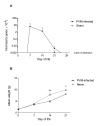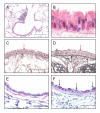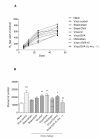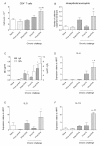Early-life viral infection and allergen exposure interact to induce an asthmatic phenotype in mice
- PMID: 20122285
- PMCID: PMC2842242
- DOI: 10.1186/1465-9921-11-14
Early-life viral infection and allergen exposure interact to induce an asthmatic phenotype in mice
Abstract
Background: Early-life respiratory viral infections, notably with respiratory syncytial virus (RSV), increase the risk of subsequent development of childhood asthma. The purpose of this study was to assess whether early-life infection with a species-specific model of RSV and subsequent allergen exposure predisposed to the development of features of asthma.
Methods: We employed a unique combination of animal models in which BALB/c mice were neonatally infected with pneumonia virus of mice (PVM, which replicates severe RSV disease in human infants) and following recovery, were intranasally sensitised with ovalbumin. Animals received low-level challenge with aerosolised antigen for 4 weeks to elicit changes of chronic asthma, followed by a single moderate-level challenge to induce an exacerbation of inflammation. We then assessed airway inflammation, epithelial changes characteristic of remodelling, airway hyperresponsiveness (AHR) and host immunological responses.
Results: Allergic airway inflammation, including recruitment of eosinophils, was prominent only in animals that had recovered from neonatal infection with PVM and then been sensitised and chronically challenged with antigen. Furthermore, only these mice exhibited an augmented Th2-biased immune response, including elevated serum levels of anti-ovalbumin IgE and IgG1 as well as increased relative expression of Th2-associated cytokines IL-4, IL-5 and IL-13. By comparison, development of AHR and mucous cell change were associated with recovery from PVM infection, regardless of subsequent allergen challenge. Increased expression of IL-25, which could contribute to induction of a Th2 response, was demonstrable in the lung following PVM infection. Signalling via the IL-4 receptor alpha chain was crucial to the development of allergic inflammation, mucous cell change and AHR, because all of these were absent in receptor-deficient mice. In contrast, changes of remodelling were evident in mice that received chronic allergen challenge, regardless of neonatal PVM infection, and were not dependent on signalling via the IL-4 receptor.
Conclusion: In this mouse model, interaction between early-life viral infection and allergen sensitisation/challenge is essential for development of the characteristic features of childhood asthma, including allergic inflammation and a Th2-biased immune response.
Figures






References
-
- Jackson DJ, Gangnon RE, Evans MD, Roberg KA, Anderson EL, Pappas TE, Printz MC, Lee WM, Shult PA, Reisdorf E. Wheezing rhinovirus illnesses in early life predict asthma development in high-risk children. Am J Respir Crit Care Med. 2008;178(7):667–672. doi: 10.1164/rccm.200802-309OC. - DOI - PMC - PubMed
Publication types
MeSH terms
Substances
LinkOut - more resources
Full Text Sources
Other Literature Sources
Medical

